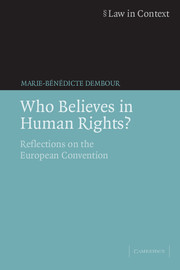Book contents
- Frontmatter
- Contents
- Acknowledgements
- Table of cases
- List of tables
- 1 Introduction
- 2 The Convention in outline
- 3 The Convention in a realist light
- 4 The Convention in a utilitarian light
- 5 The Convention in a Marxist light
- 6 The Convention in a particularist light
- 7 The Convention in a feminist light
- 8 The human rights creed in four schools
- 9 Conclusion: In praise of human rights nihilism
- Appendices
- Select Bibliography
- Index
2 - The Convention in outline
Published online by Cambridge University Press: 03 February 2010
- Frontmatter
- Contents
- Acknowledgements
- Table of cases
- List of tables
- 1 Introduction
- 2 The Convention in outline
- 3 The Convention in a realist light
- 4 The Convention in a utilitarian light
- 5 The Convention in a Marxist light
- 6 The Convention in a particularist light
- 7 The Convention in a feminist light
- 8 The human rights creed in four schools
- 9 Conclusion: In praise of human rights nihilism
- Appendices
- Select Bibliography
- Index
Summary
The next chapters will discuss theoretical critiques of human rights with reference to cases decided by the European Court of Human Rights. This will be done without explaining how these cases have emerged and how they fit into European human rights law. The present chapter offers a ‘black-letter law’ introduction to the European Convention on Human Rights, especially for the benefit of the reader who is not familiar with it.
In the Anglo-Saxon legal jargon, the expression ‘black-letter law’ refers to the law which can be read, printed on paper, in legislative, judicial and possibly doctrinal documents. A black-letter study stresses the letter of the law, without paying much attention to its theoretical, political or social significance; its main aim is to investigate what a lawyer can do with the law. Black-letter accounts can be highly sophisticated or thoroughly rudimentary. The introduction offered here is of the latter kind.
The work of the Council of Europe
The European Convention on Human Rights owes its existence to the Council of Europe. This European organization must not be confused with the European Community/Union. It was set up in 1949 as one of a number of initiatives to secure peace and security in Europe. Originally made up of ten states, it now counts forty-six member states, including Turkey (since 1949) to the south and the Russian Federation (since 1996) to the east.
- Type
- Chapter
- Information
- Who Believes in Human Rights?Reflections on the European Convention, pp. 19 - 29Publisher: Cambridge University PressPrint publication year: 2006



